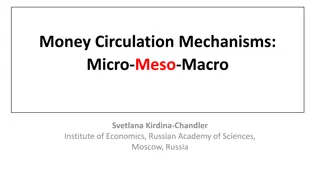
General EQA Scheme Educational Cases with Dr. Kate Struthers on Skin Adnexal Tumors in Scotland and Northern Ireland
Explore educational cases with Dr. Kate Struthers focusing on a 55-year-old patient with a 9mm papule on their right temple. The cases delve into different types of skin adnexal tumors, including lymphadenoma variants, benign and malignant tumors, and differential diagnoses. Detailed slides and descriptions aid in understanding the complexities of these skin conditions.
Download Presentation

Please find below an Image/Link to download the presentation.
The content on the website is provided AS IS for your information and personal use only. It may not be sold, licensed, or shared on other websites without obtaining consent from the author. If you encounter any issues during the download, it is possible that the publisher has removed the file from their server.
You are allowed to download the files provided on this website for personal or commercial use, subject to the condition that they are used lawfully. All files are the property of their respective owners.
The content on the website is provided AS IS for your information and personal use only. It may not be sold, licensed, or shared on other websites without obtaining consent from the author.
E N D
Presentation Transcript
Scotland and Northern Ireland General EQA Scheme Educational cases E1&E2 Dr Kate Struthers
E1 55 year old 9mm papule right temple
E1 CD45
E1 84 responses Cutaneous Lymphadenoma (24) Cutaneous lymphadenoma, trichoblastoma variant (3) Cutaneous lymphadenoma, adamantanoid trichoblastoma (1) Cutaneous adenolymphoma (1) Lymphadenoma (6) Lymphadenoma, variant of trichoblastoma (1) Adnexal tumour (1) Benign skin adnexal tumour (2) Adnexal tumour ?cutaneous lymphadenoma (1) Adnexal tumour ?lymphadenoma (1) Adnexal tumour with features of desmoplastic trichoepithelioma (1) Adnexal tumour ?malignant (1)
E1 Benign skin appendage tumour (?eccrine spiradenoma?cutaneous lymphadenoma) (1) Skin adnexal tumour favour hair follicle origin ?trichepithelioma (1) Skin adnexal tumour ?hair follicle origin (1) ?skin appendage tumour ?cutaneous lymphadenoma (1) Skin adnexal tumour (1) Skin adnexal tumour ?microcystic adnexal carcinoma (1) Benign skin appendage tumour with hair follicle differentiation ?trichoepithelioma or trichoblastoma (1) Skin adnexal tumour, favour trichoblastoma (1) Malignant skin adnexal tumour (1) Incompletely excised adnexal tumour. Appears to have some tricholemmal differentiation but not typical of desmoplastic variant (1) Skin appendage tumour ?cutaneous lymphadenoma (1) DD sebaceous carcinoma, skin appendage carcinoma, metastatic carcinoma. Needs IHC (1) Skin adnexal tumour ?trichelemmoma (1)
E1 Trichepithelioma (4) Trichoblastoma (1) Trichoblastoma, adamantinoid variant (1) Trichoblastoma ?adamantinoid variant (1) Adamantinoid trichoblastoma (1) Trichoblastoma vs basal cell carcinoma, IHC (1) Trichoblastic carcinoma (1) Tricholemmal carcinoma (2) ?desmoplastic trichilemmoma (1) ?desmoplastic trichilemmoma (1) Desmoplastic trichoblastoma (1) Desmoplastic trichilemmoma (1)
E1 Microcystic adnexal carcinoma (2) Sebaceous carcinoma (4) Sebaceous gland carcinoma (1) Inflamed spiradenoma (1) Eccrine spiradenoma (1) Some sort of poro-carcinoma (1) Basal cell carcinoma, nodular and infiltrative (1) Organoid basal cell carcinoma (1)
Cutaneous lymphadenoma Rare benign skin adnexal tumour Variant of trichoblastoma adamantanoid trichoblastoma Wide age range 14-87 Clinical presentation: Single, small flesh-coloured nodule; well circumscribed, slowly enlarging. Present for months/years Site: Face, scalp, legs
Cutaneous lymphadenoma Histology: Well circumscribed dermal lesion Variable connection to epidermis Rounded islands / nests epithelial cells Embedded in loose-dense stroma Outer rim palisading cells, no retraction artefact Dense infiltrate of small, mature lymphocytes in lobules Some central keratinisation May be focal follicular or sebaceous differentiation Mitoses rare IHC: Not necessary for diagnosis Lymphocytes + CD45, polymorphous + AE1/3
Cutaneous lymphadenoma Management: surgical excision Differential diagnosis: Basal cell carcinoma atypia / mitotic activity / retraction artefact Trichoblastoma lacks lymphocytes
E2 60 year old female Large necrotic uterine tumour
Vimentin ER MNF
E2 84 responses Adenosarcoma (56) Adenosarcoma of uterus (1) Adenosarcoma, but would have to sample widely to check no carcinoma element (1) Adenosarcoma (high grade) (1) Adenosarcoma (leiomyosarcoma) (1) Adenosarcoma with sarcomatous overgrowth (1) High grade adenosarcoma (1) Mullerian adenosarcoma (5) Uterine / Mullerian adenosarcoma (1)
E2 Carcinosarcoma (7) Carcinosarcoma vs adenosarcoma (1) Adenosarcoma or carcinosarcoma (1) Biphasic tumour .DD Adenosarcoma with sarcomatous overgrowth or carcinosarcoma (1) Uterine sarcoma (1) Uterine sarcoma, needs IHC (1) Malignant mixed Mullerian tumour (1) Leiomyosarcoma (1) Leiomyosarcoma with benign epithelial elements (1) High grade endometrial stromal sarcoma (homologous) (1)
Uterine (Mullerian) adenosarcoma Mixed epithelial and stromal tumour malignant stroma with benign epithelial component Incidence highest in perimenopausal or postmenopausal women Risk factors: Endometriosis, pelvic radiotherapy, long term unopposed oestrogen and tamoxifen Clinical presentation: Abnormal bleeding, pelvic pain, incidental Diagnosed on endometrial biopsy
Adenosarcoma Macroscopy: Often polypoidal, filling endometrial cavity Cut surface solid and white containing microcysts/mucoid material Microscopy: Biphasic tumour with admixed glands and stroma Stroma cytologically atypical with mitotic activity Epithelium usually endometrioid, but can show mucinous, tubal or squamous metaplasia
Adenosarcoma Low grade monotonous stromal nuclei, mild to moderate atypia High grade pleomorphic, markedly atypical nuclei noticeable at low power Sarcomatous overgrowth sarcoma without any epithelial elements in >25% of the tumour Heterologous elements most commonly rhabdomyosarcoma Immunohistochemistry Glands: AE1/3, ER, PR Stroma: Vimentin, CD10, WT1, ER, PR; variable smooth muscle markers
Uterine sarcomas FIGO staging Adenosarcoma staged in a comparable way to endometrial carcinomas, as they tend to arise on the surface and progressively invade the myometrium or cervical stroma Leiomyosarcomas and endometrial stromal sarcomas arise within the myometrium and are staged differently, as are undifferentiated sarcomas and pure heterologous tumours Carcinosarcoma staged as carcinoma of the uterine corpus






















